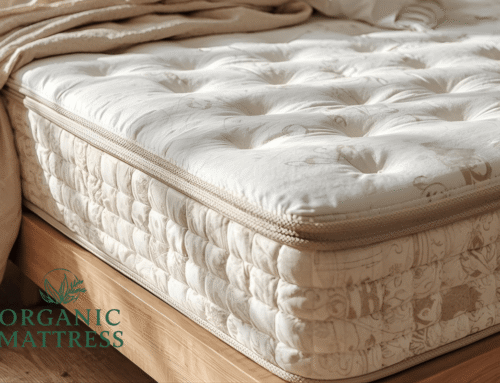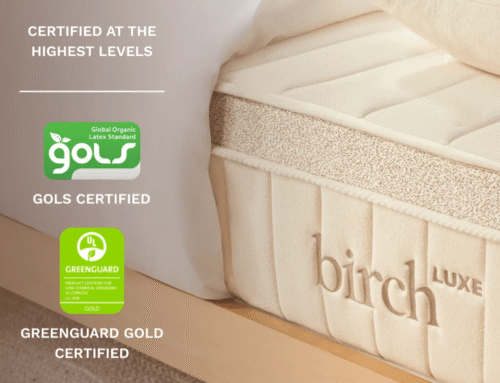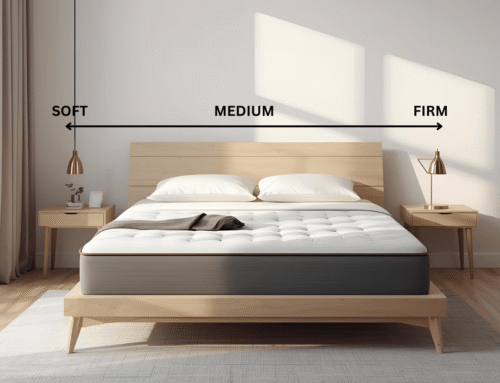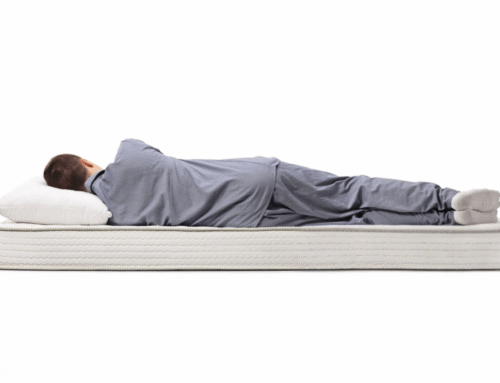A lot of people love the classic feel of an innerspring mattress. It’s responsive, firm, and usually sleeps cooler than foam beds. But that bouncy comfort doesn’t always hold up forever. On average, most innerspring mattresses start to lose support after about 6 to 8 years, especially if the top layers are thin or made with low-density materials.
Coils can hold their shape for a while, but the padding above them wears out first. Motion transfer and creaky noises also become more noticeable over time. Flipping or rotating the bed regularly and using a supportive base can help delay those issues, though it won’t completely stop the wear.
This guide breaks down how long a typical innerspring mattress lasts, which factors affect that timeline most, and what helps extend its comfort. It also covers how body weight, sleep habits, and coil type play into the equation.
Key Takeaways
- An innerspring mattress uses metal coils for support, with soft foam or fiberfill layers on top to add comfort and bounce.
- Pocketed coils isolate motion effectively, while Bonnell and continuous coils deliver firmer, traditional support at a lower price.
- On average, innerspring mattresses last six to eight years, though coil quality and comfort layer materials influence lifespan.
- Rotating the mattress regularly, using a mattress protector, and ensuring proper bed frame support extend durability and reduce sagging.
- When back pain, sagging, or spring noises occur, replace your innerspring mattress with a supportive, updated model.
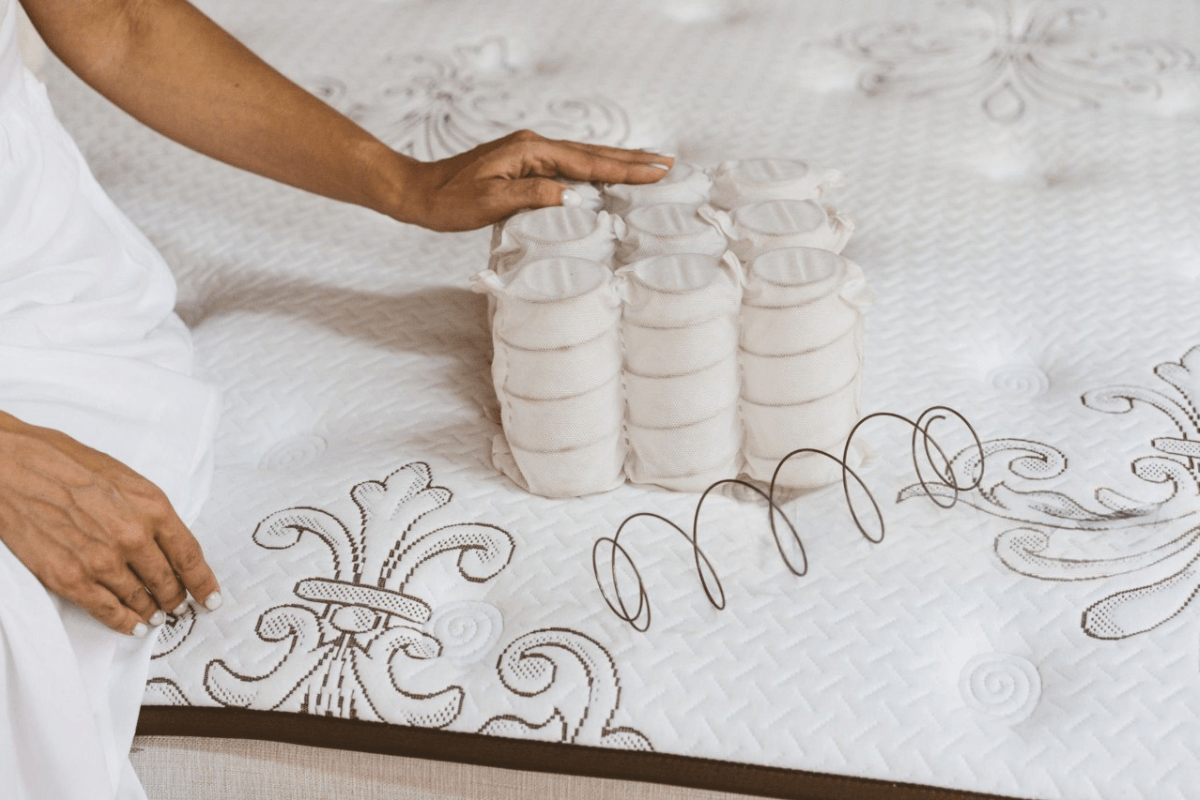
What Is Inside An Innerspring Mattress?
To better understand innerspring mattresses it helps to know key facts such as who invented the first innerspring mattress, the differences between innerspring and pocket coil mattresses, how hybrid mattresses compare to innerspring models, and the typical weight of an innerspring mattress. An innerspring mattress relies on metal coils to provide structure and support. The springs respond quickly to movement which gives the surface a bouncy, lifted feel. On top of the coils, most models include a layer of foam or fiberfill that softens the surface just enough for basic comfort.
Bonnell coils, the classic hourglass-shaped ones, are often firmer and more budget-friendly. Pocketed coils move on their own, so they’re quieter and better at isolating movement between sleep partners. Some beds use a continuous coil system, which feels sturdy though not as contouring as other options. Each coil design creates a slightly different sleeping experience depending on personal preference.
Compared to memory foam or latex, innerspring beds usually cost less and tend to stay cooler throughout the night. Air flows more easily through the open coil structure, which can be helpful for those who sleep hot. These mattresses suit people who want something firmer and responsive without sinking too deep.
Average Lifespan of an Innerspring Mattress
Most innerspring mattresses tend to stay supportive for around 6 to 8 years. Beds with thicker coils and higher-quality foam layers may last longer, closer to 9 or even 10 years, especially with consistent rotation and a solid foundation. Beds that get less use or lighter weight sleepers often see less wear over time.
On the other hand, budget models or mattresses used by multiple people might begin to feel uneven or dip in certain areas after 4 to 5 years. The type of coil system, like pocketed coils versus Bonnell springs, affects how long the mattress stays firm and comfortable. Thinner comfort layers wear down faster and can lead to early sagging.
Noticeable dips, back pain after sleep, or even loud springs often signal that the bed isn’t holding up anymore. These signs usually show up before the 8-year mark, depending on usage and care. At that point, it might be time to start looking for a replacement.
Factors That Affect Innerspring Mattress Lifespan
How often to turn an innerspring mattress and its effect on lifespan are important factors to consider. Some innerspring mattresses hold up better than others, and that depends on the design and usage. Those who’ve owned several types usually notice which ones start sagging early and which ones keep their shape over the years. Construction and care both shape how long the mattress actually lasts.
- A mattress with thicker and tempered coils tends to stay supportive longer
- Cheaper comfort layers, especially low-density foam, break down faster than latex or high-density foam
- Heavier individuals or couples add more pressure, which wears down coils and padding over time
- A mattress used every night ages quicker compared to one in a guest room
- More tossing and turning leads to faster deterioration in the springs and surface foam
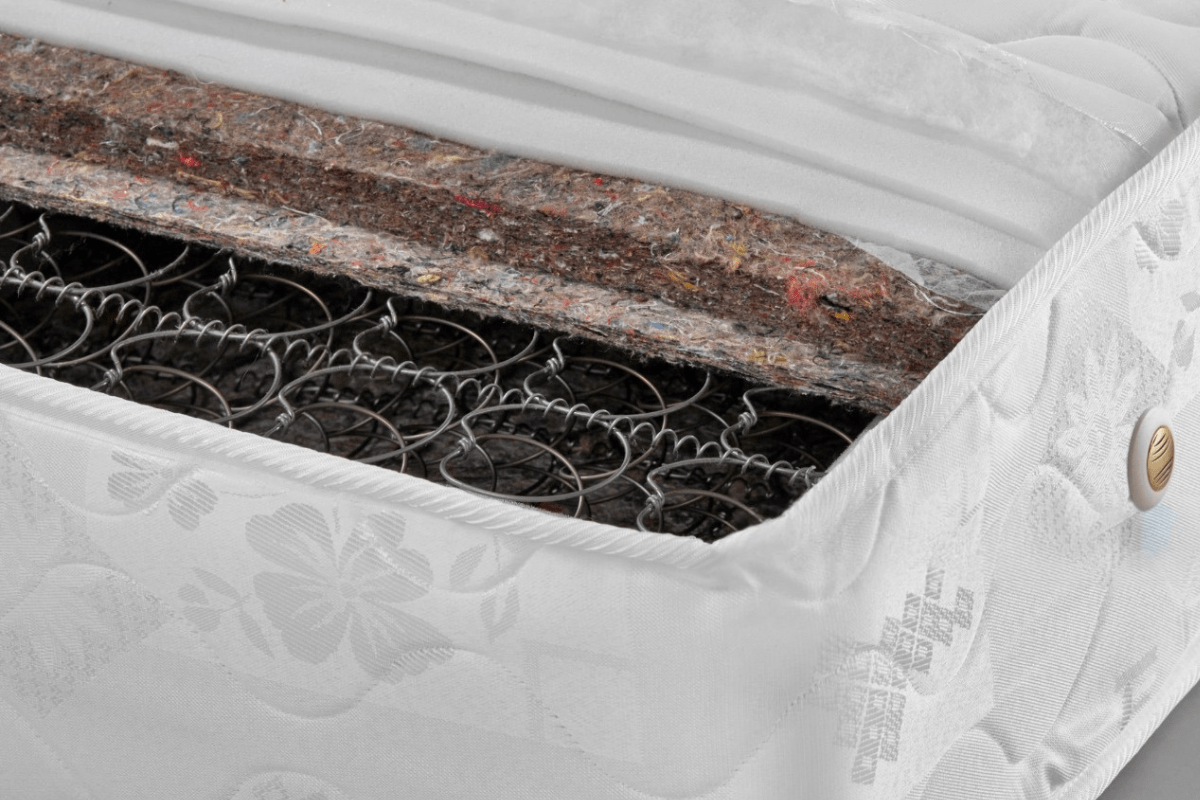
Signs Your Innerspring Mattress Needs Replacing
Over time, an innerspring mattress starts to lose its shape, especially when the coils wear down or the top layers thin out. Deep impressions or dips that stay even after getting out of bed usually mean the support is no longer there. A mattress that no longer holds a flat, even surface often causes uneven pressure and restless sleep.
Coils pushing through the top or sharp pressure points across the back often suggest the inner layers have broken down. If every shift leads to a creak or squeak, that’s another clue the materials inside have worn out. Sounds like these usually mean the springs aren’t holding together properly anymore.
Back or hip pain that feels worse in the morning than at night might not be from aging or stress. For many people, it’s actually a sign their bed stopped giving proper support. Instead of feeling rested, sleep feels like a chore. A mattress that once felt firm may now sag, which can leave the body misaligned throughout the night.
How to Make Your Innerspring Mattress Last Longer
An innerspring mattress can stay comfortable for years with just a few regular habits. Rotating it every few months helps distribute pressure evenly so one side doesn’t break down faster than the other. This small step prevents dips or sagging, especially for those who sleep in the same spot each night.
Adding a mattress protector is worth considering. It helps block spills, sweat, and everyday grime from reaching the top layers, which often wear out first. A clean surface not only feels better but also slows down long-term damage. A quick vacuum now and then keeps dust and allergens in check.
It’s also better to check the bed frame from time to time. A center support beam matters more than people realize, especially for queen or king sizes. Kids love jumping on beds, but those metal coils can only handle so much. With the right care, an innerspring mattress can stay supportive well beyond the usual 6-8 year range.
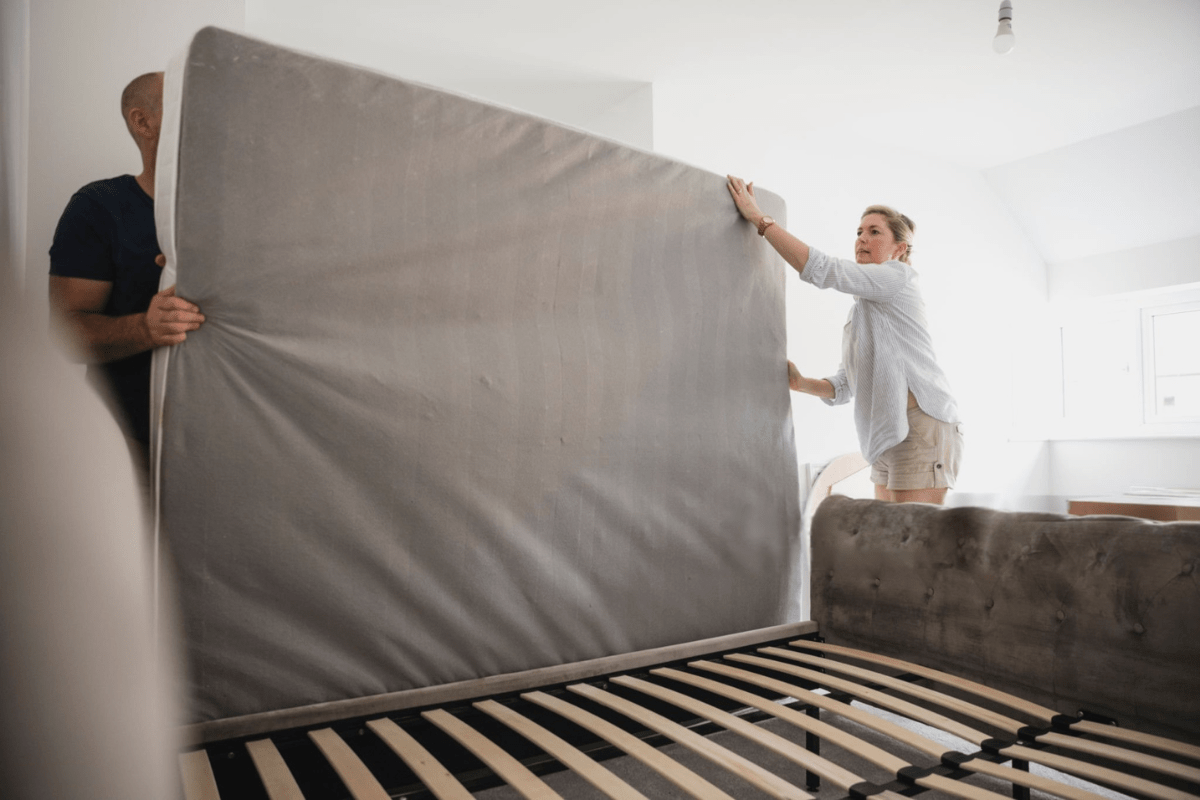
Do Mattress Warranties Cover Lifespan?
Mattress warranties run between 5 to 10 years, especially for innerspring models. That sounds reassuring at first, though the coverage tends to focus on factory defects. Sagging deeper than 1.5 inches or broken coils usually qualify, but general wear and loss of comfort don’t.
Most warranties require proper support under the mattress. That means using the recommended foundation and avoiding things like old box springs or slats that are too far apart. Forgetting to rotate the bed or exposing it to moisture could also risk losing coverage.
Warranties help with manufacturing flaws, not how long the mattress stays comfortable. Even if the bed feels lumpy after five years, that wouldn’t count unless it meets the specific defect criteria. A lot of people assume warranty equals full protection, though it rarely works that way.
Comparing Lifespans of Different Mattress Types
Choosing between innerspring mattress and memory foam and deciding which is right for you requires understanding how their lifespans and feelings differ. Latex mattresses tend to last the longest, often reaching 10 to 15 years, since the material resists sagging and holds its shape better over time. They feel a bit more buoyant than memory foam, which some people prefer for ease of movement during sleep. Though they cost more upfront, the extended lifespan balances that out.
Memory foam and hybrid mattresses usually last around 8 to 10 years, depending on the density of the foam and how often the bed gets used. Hybrids include coils, so they sometimes wear down faster in the middle, especially if only one side of the bed is used regularly. Both types feel cushy at first but may develop body impressions over time.
Innerspring beds generally hold up for 6 to 8 years, which is shorter than the rest. Still, some stick with them because they’re breathable, affordable, and feel firmer from the start. A mattress topper and regular rotation help extend the comfort, though sagging eventually shows up in high-pressure areas.
Best Time to Replace an Innerspring Mattress
Most people start noticing their mattress needs replacing once sleep feels more like a chore than rest. Waking up with back pain, stiffness, or lingering soreness can signal the springs are no longer doing their job. Even with no visible damage, an innerspring mattress that causes poor sleep is usually past its prime.
After about 6 to 8 years, innerspring mattresses tend to lose support, especially if used daily. Sagging, lumpy spots, or fabric that looks torn or stretched often show up around this time. Some even notice the metal coils getting louder or poking through, which usually means the structure underneath has started breaking down.
A fresh mattress usually leads to deeper rest and fewer body aches, especially for side or back sleepers. Many also report waking up with more energy and focus. Even those who didn’t think they had sleep issues sometimes feel surprised by how much better rest feels on a supportive and updated mattress.

Tips When Shopping for a New Innerspring Mattress
Knowing how to pick the best innerspring mattress and understanding the ideal number of coils an innerspring mattress should have are key factors in finding the right mattress. Shopping for an innerspring mattress starts with checking the coil count and gauge. A higher number of coils usually offers more consistent support, while thicker gauge coils feel firmer and last longer. Some brands exaggerate coil numbers, so it helps to check for balanced construction rather than just high counts.
Mattresses with pocketed coils tend to reduce motion transfer between sleep partners. Each coil moves independently, so the surface feels more responsive without too much bounce. This design is great for people who share a bed or tend to move a lot at night.
Many sleepers now lean toward hybrid styles, which pair foam with coils for added comfort. A soft pillow top may feel cozy at first, though it often compresses faster than denser materials. Brands that allow in-home trials or have flexible return policies help buyers find the right fit without pressure.
Final Thoughts
Innerspring mattresses provide solid support and allow good airflow, which helps keep sleepers comfortable. Their durability often depends on the quality of the coils and the materials used in the layers above. Over time, the foam or padding can start to break down, which can lead to less comfort and support.
Typically, these mattresses last between six and eight years, though this can vary based on usage and maintenance. Regularly rotating the mattress and using a protective cover can help slow down wear and tear. Paying attention to any sagging or lumps is important to know when it’s time for a replacement.
Though innerspring mattresses don’t last as long as some newer types, their combination of breathability and support appeals to many sleepers. Proper care extends their usefulness, but eventually, signs of aging will appear. At that point, it’s best to consider investing in a new mattress for healthier sleep.

